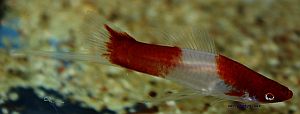A mutation of the pectoral fins Xiphophorus hellerii and its importance



Translated using Google
During a visit to the breeder Wolfgang Brandt, showed me this a "koi" hellerii with significantly longer pectoral fins. Longer than it "normal" Lyraflosser knows.
Those looking for attention in his breeding stock, can find something.
I myself had already received an animal with the same feature by an observant aquarists.
Likewise came before an extended pectoral fins at Kings-Lyra.
Such examples show that each fin feature can be edited individually, but also provide breeding occurs singly.
Why is this important to me?
For a long time it was assumed that the fins feature "Lyra" to look like a single inheritable trait and therefore the type Lyraflosser is unchangeable. In a way, because "guilt" is that Xiphos be judged according to standards at exhibitions, the fact therefore also arise breeding objectives. As a result many farmers gave the impression that a standard has a genetic significance. That's just not so. A standard is important! But, one should not it just make the wrong conclusions. For decades, for example, assumed that the long gonopodium of the male Lyraschwertträgers the mark of those immutable belongs.
Currently, some breeders go, or those who should prove to be of the breeder of Xiphophorus breeds only once, assuming that the characteristic of the shorter "top sword" when Kings-Lyra would be a consolidated feature. Why go this from them? Because they do not actually know what they talk or even write!
The following pictures is a little unclear. The cause lies in the circumstances of the creation of the photo, as well as the nature of the imaged transparent white fin albino Koischwertträgers. I tried to change the color settings of the photos so that the pectoral fins and the gonopodium are still somewhat visible.
